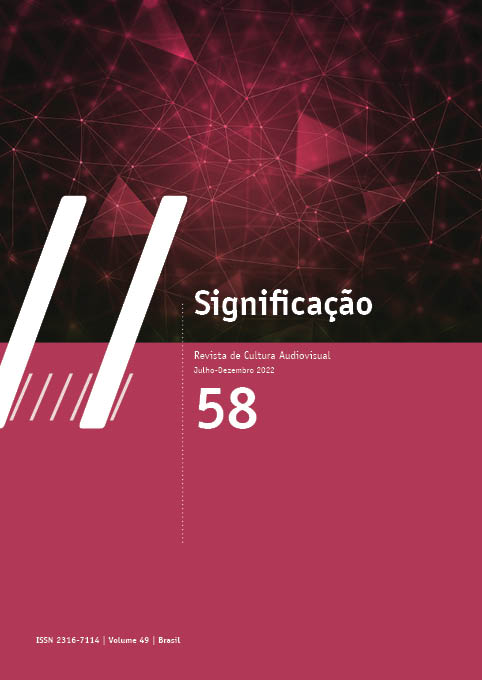Real and animated body in Chris the Swiss
DOI:
https://doi.org/10.11606/issn.2316-7114.sig.2022.190348Keywords:
Representation and memory, Animated documentary, Sensitive representation strategiesAbstract
This article discusses the narrative resources used in animating a filmic narrative based on testimonies of 20th century war stories. The film work Chris the Swiss, by illustrator and filmmaker Anja Kofmel, is analyzed, establishing as main argument the use of animated materials to mobilize and elaborate aspects of the traumatic past, a characteristic that has emerged with some frequency in contemporary documentary cinema. To do so, the most recent authors on animation documentary are discussed together with film analysis, presenting as main focus the use of animation when defining in sensitive discourses the very nature of the cinematographic image.
Downloads
References
ASSMAN, A. Espaço da Recordação: Formas e Transformações da Memória Cultural. Campinas: Unicamp, 2011.
BECKMAN, K. Animated Film Theory. Durham: Duke University Press, 2014.
CRAFTON, D. Before Mickey: Animated Film 1898-1928. Cambridge: MIT Press, 1982.
DIDI-HUBERMAN, G. Levantes. São Paulo: Sesc SP, 2017.
FENOLL, V. “Animación, Documental y Memoria. La Representación animada de la dictadura chilena”. Cuadernos.info, Santiago, n. 43, p. 45-60, 2018.
FOSTER, H. O que Vem Depois da Farsa. São Paulo: Ubu, 2021.
HARTMAN, G. “Holocausto, testemunho, arte e trauma”. In: SELIGMANN-SILVA, M. (org.). Catástrofe e Representação. São Paulo: Escuta, 2000. p 207-235.
KOFMEL, A. “Nuestra sociedad es vulnerable y fácil de manipular por la politica y los medios”. [Entrevista cedida a] Vladan Petkovic. Cineuropa, [S. l.], 22 mai. 2018. Disponível em: https://bit.ly/3BTDoup. Acesso em: 21 set. 2022.
RANCIÈRE, J. A partilha do Sensível. São Paulo: Editora 34, 2005.
ROE, A. H. Animated Documentary. London: Palgrave Macmillan, 2013.
ROTHBERG, M. Traumatic Realism: The Demands of Holocaust Representation. Minnesota: University of Minnesota Press, 2000.
SELIGMAN-SILVA, M. História, Memória, Literatura: O Testemunho na Era das Catástrofes. São Paulo: Unicamp, 2003.
SELIGMAN-SILVA, M. “Toda Política é Política das Imagens”. In: KAMINSKI, R.; HONESKO, V.; SEREZA, L. C. (orgs.). Artes & Violências. São Paulo: Intermeios, 2020. p 159-181.
SERRA, J. J. “O Documentário Animado: Quando a Animação encontra o Cinema do Real”. Revista Rumores. ed. 10, 2011.
SERRA, J. J. “O Documentário Animado: Novas Abordagens na Representação da Realidade”. In: MAURÍCIO S. G. (org.). Pesquisa em Animação: cinema e poéticas tecnológicas. Belo Horizonte: Ramalhete, 2019. p 56-70.
WARD, P. Documentary: the margins of reality. London: Wallflower paperback, 2005.
ABUELAS. Afarin Eghbal, Reino Unido, 2011.
CRIS the swiss. Anja Kofmel, Suiça, 2018.
EL TECHO del Mundo. Rémi Chayé, França-Dinamarca, 2015.
FUNAN. Denis Do, França, 2018.
GOING Equipped. Peter Lord, Reino Unido, 1990.
GOLPE de Espejo. Claudio Díaz, Chile, 2008.
Downloads
Published
Issue
Section
License
Copyright (c) 2022 Rafael Tassi Teixeira

This work is licensed under a Creative Commons Attribution-NonCommercial 4.0 International License.
Authors who publish in this journal must agree with the following terms:
- Authors keep their copyrights and grant the journal first time publication rights, having their articles simultaneously licensed under the Creative Commons Attribution License, which allows sharing texts with authorship recognition and first publication on this journal for non-commercial purposes.
- Authors are allowed to make additional contracts, for a non-exclusive distribution of the article’s version published on this journal (e.g.: publishing in institutional repositories of articles or as a book chapter), with authorship recognition and first publication on this journal.
















